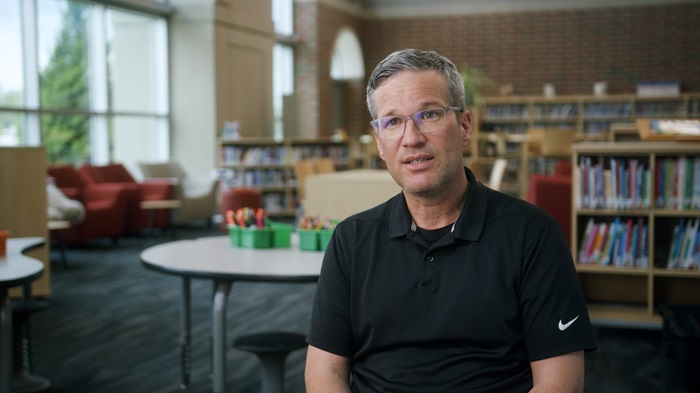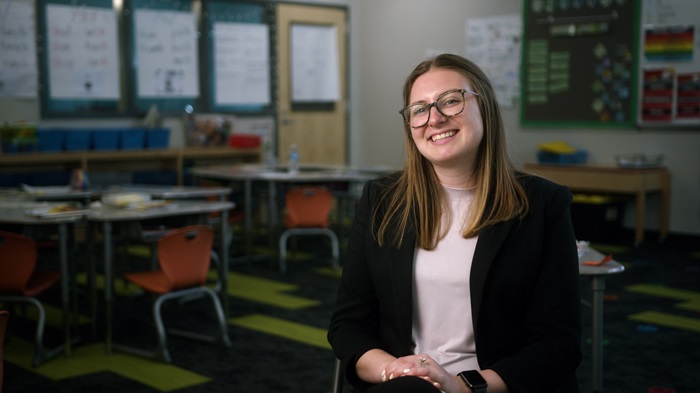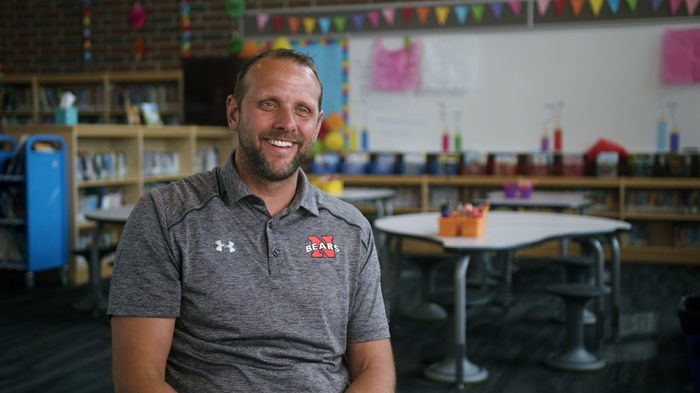Ohio elementary schools are moving to the Science of Reading, an approach that emphasizes phonics along with vocabulary- and knowledge-rich content. Keen on learning what this transition looks like inside classrooms, we asked Ellen Belcher, a former journalist with the Dayton Daily News, to visit Northridge Local Schools to shine light on their literacy practices. Read below or download the report to learn more about Northridge's approach to reading curriculum and instruction.
Be sure also to check out this companion video to hear Northridge Local Schools administrators and teachers talk about adopting curricula based on the Science of Reading:
Northridge Local Schools was in the vanguard of Ohio school districts that have adopted reading curricula based on the Science of Reading.
The district started on the path in 2018, five and a half years before Gov. Mike DeWine signed a budget bill in July 2023 requiring that Ohio public schools teach students using the evidence-based approach and dedicating $168 million to the effort.
Even without a mandate, Northridge was motivated to embrace the Science of Reading, which was beginning to gain traction nationally. The small district, just north of Dayton, ranked in the lowest 5 percent of districts in the state by performance, triggering state education officials to step in with offers of help.
“When you’re not performing well, it’s easy to change,” Superintendent Dave Jackson said in an interview. On the other hand, many districts that historically have had strong reading scores are struggling to make the dramatic and expensive shift to Science of Reading-based curricula. Teachers and administrators in those districts are “not excited” about the change, Jackson said.
Harkening back to 2018, Todd Petty, who was then Northridge’s Pre-K and kindergarten principal and now is an elementary school student success administrator, said, “My data were not good. I was doing the best I could, but I wasn’t getting results.”

Student Success Administrator
Today, things are looking up in the district of 1,576 students, all of whom are identified as economically disadvantaged.
In February 2024, administrators learned its elementary school is no longer in “Comprehensive Support and Improvement School Status,” a federal designation for a low-performing school. For two consecutive years, it has made enough academic improvement to shed that label.
Jackson is most proud of the uptick in early elementary students’ reading progress, a success that he said is attributable to the adoption of curricula based on the Science of Reading.
Though Jackson readily concedes that the district has much more to do—only 36 percent of students passed the third-grade reading proficiency test in 2022–23, the most recent year for which statistics are available—its youngest learners are making impressive, though erratic, gains.
At the start of the 2023–24 school year, 21 percent of kindergarteners were at or above the appropriate early literacy level for entering school, according to Acadience assessments, a popular progress monitoring tool for teachers. By the end of the school year, 66 percent tested at or above grade level. In other words, almost half of children had caught up and achieved more than a year’s growth.
The year prior was especially remarkable—28 percent of kindergarten students started the school year at or above literacy benchmarks expected of children entering kindergarten. By the end of the year, 82 percent had mastered the skills they needed to be considered achieving on grade level for kindergartners about to enter first grade.
Disappointed though they are regarding the most recent data, administrators believe they are moving in the right direction. They will be looking hard at the ongoing reading progress of the 2023– 24 kindergartners and first graders, who were the first groups taught solely with curricula based on the Science of Reading, after several years of district preparation for the instructional transition. As literacy achievement increases “slowly but surely,” Jackson believes, students’ scores should improve as they progress into the upper grades. He also believes that achievement in other subjects will improve because reading is so central to learning.
Teachers note that quick gains in literacy are made most easily with kindergarten students, but Northridge’s success is significant even so.
As children advance in their school careers (and especially so for those experiencing poverty), it becomes increasingly difficult to gain more than a year’s worth of learning in a year’s time, with gaps compounding year over year.
Likening the challenge to catching up to a lopsided basketball game, Petty said, “If you’re getting beat 65–2 at the end of the first quarter, you’re probably going to lose. That’s why getting kids on grade level (early) is a very big deal.” The district, he said, is focused on “defying the predictive power of demographics” and sustaining that achievement in succeeding grades.
Teachers are asked to do much more
The six years since Northridge began adopting Science of Reading-based curricula have been difficult, administrators and teachers agree. They insist that intensive professional development and coaching have been at the heart of the work.
They add that new systems around data analysis, intervention and progress monitoring, and an administrative restructuring have been important, too. Taken together, the changes have ensured that Science of Reading principles are increasingly practiced well and institutionalized.
The first step the district made toward adopting Science of Reading curricula was requiring all K–5 teachers to take demanding training in LETRS (Language Essentials for Teachers of Reading and Spelling) starting in 2018. Today, all new teachers must complete the course unless administrators are confident that they’ve had similar training in college or at a previous job.
Northridge teachers have come to love LETRS, once they make it through the program’s two weighty, spiral-bound textbooks. Initially, they were trying to complete the training in one year, but the modules were so time-consuming that they asked administrators to give them double that time. They were paid for eight hours at their contracted rate as they completed each unit.
“It was like taking multiple college courses while teaching,” said Petty. “It was technical. You couldn’t breeze through. Teachers were accountable to know the material.”
Progress arguably should have stalled during the second year of LETRS training, when the district struggled with a cascade of overwhelming events.
When students came to school in fall 2019, many were still reeling from that year’s Memorial Day weekend tornadoes, which leveled swaths of the school community, destroying many families’ homes and ripping off the roof of one school. Teachers and students also were moving into a new $55 million building that consolidated all the district’s schools into one complex; school started a month late because of construction delays. Then, in early 2020, COVID-19 broke, sending students home for weeks and forcing them into online learning.
At the same time teachers were immersing themselves in LETRS, a committee had begun choosing a new reading curriculum based on the Science of Reading, replacing instructional materials that used Whole Language, Balanced Literacy and Three-Cueing. Those methods encourage students to guess words based on context and to look at pictures—practices that are not rooted in the Science of Reading, which emphasizes phonics and decoding of words. Ultimately, the district chose Amplify’s Core Knowledge Language Arts.
Switching to a new curriculum is invariably challenging, but in this case, teachers had to learn dramatically new ways of teaching.
Because of the gradual ramp-up that accompanies instituting a new curriculum, it wasn’t until the 2022–23 school year that Amplify was fully implemented. Two years in, educators, including former naysayers, say they’re sold on the program because of its rigor—and the improvements in reading they’re seeing.
“We didn’t think our kids could handle it,” said Julie Russell, a kindergarten teacher. “We were the stuck-in-the-mud ones. Now, we’re like, ‘Yes, yes, yes.’”

Kindergarten teacher
“I’ve not seen things work like they’re working now”
Prior to the district adopting Science of Reading curricula, teachers could choose whatever materials they wanted to teach reading. But now, using Amplify is non-negotiable.
“I’ve not seen things work like they’re working now,” said Tina Kretzer, the district’s K–5 literacy coach and a 38-year education veteran. “I’ve been in places where initiatives are rolled out, materials are adopted, and I’ve not seen the impact it’s making here,” she said. “The expectation is clear that this is how we operate in Northridge.”
With the district’s success, Superintendent Jackson said some teachers have been reduced to tears as they’ve realized the shortcomings of their previous instruction, especially for struggling readers. He, too, has remorse, explaining that it wasn’t until “eight years into my superintendency” that the district adopted curricula based on the Science of Reading.
“You start to feel like you failed kids,” Jackson said. “You start to think, ‘I didn’t lead well.’”
When Jackson imposed an administrative restructuring in 2021–22, emphasis increased on implementing Science of Reading practices. Some teachers mourned the loss of the classroom autonomy they once had, arguing that Amplify is too rigid and that the “art of teaching” was being lost. A few teachers quit.
Jackson said one veteran teacher who resigned said she couldn’t “keep up” with changing her teaching methods so dramatically after so many years, that she felt like a “first-year teacher” all over again.
Despite the difficulties, Kretzer said most teachers are learning and adjusting, making Amplify lessons “come alive” for children. “We’re talking about the Renaissance in the fifth grade. We’re no longer teaching to the lower-performing students.”
Teachers said they like that Amplify units are reinforced in each succeeding grade level, with increasingly complex vocabulary and deeper dives into subject matter.
In kindergarten through second grade, time is set aside every day to read aloud because students’ listening comprehension is always more advanced than their reading comprehension.
Samantha “Sam” Mack, who taught kindergarten for the first time in 2023–24, said that adjusting to Amplify was not difficult because her literacy preparation at the University of Dayton was based on the Science of Reading and she completed LETRS training in college. She believes that having previously taught second grade is an advantage because she knows “where my students need to go.”

Kindergarten teacher
She especially likes Amplify’s “skills block,” she said. “The students work with words. We analyze patterns, work with ‘tricky words,’” Mack said. Each unit’s “read-alouds” are about two years above grade level, with the unit on colonial times, for instance, introducing words like “barter,” “apprentice” and “cobbler.”
In April, students were eagerly tackling a book about a child with a friend who has diabetes and needs an insulin pump. This was after they had been writing and reading their “tricky” words that “do not play by the rules.”
Devoting Amplify’s required two hours to reading instruction pushes teachers to keep a “perky pace,” Mack said, but her students have settled into a routine that allows them to stay on track. The key is to “condense, not cut,” she said.
Teachers are sometimes overwhelmed by the constant progress monitoring that’s required and using that data to identify each student’s skill gaps, on top of implementing more demanding curricula. “(Using Amplify and LETRS) requires a lot more work,” Mack said.
Though teachers said Amplify has flaws (there’s little emphasis on writing words and sentences in kindergarten, for instance), Jenn Jackson, who teaches third grade, said it’s the best curriculum she has used in her ten-year career. This year, her students have tackled animal classification; the skeletal, nervous and digestive systems; ancient Rome; light and sound; and Norse and Native American cultures. In April, students were acting as “time travelers” and comparing day-to-day life in colonial America with other historical periods they had studied, learning vocabulary words like “distinct” and “originally.”
“You can ask any of my kids what the speed of light is, and they can tell you,” said Jackson. Five of the sixteen students in her class were on Individualized Education Plans (IEPs). “They love the (rich and complex) content. I have every kid in my class with their hand up.”
For children who struggle with reading—about half the student population in grades K–2—intervention is highly systematized. At the start of the school year, all students are assessed and assigned to a Tier 1, 2 or 3 reading group. Students in Tiers 2 and 3 receive an additional thirty minutes of reading help. Teachers or instructional assistants provide that intervention, often in cross-grade groups of six or fewer.
Children are formally assessed every other week, except those in the lowest reading group, who are assessed every week. A team of administrators and teachers meets weekly to go over students’ individual data and pinpoint what intervention is needed.
Tony Hiser, the elementary school building administrator, said ten instructional assistants (who must have at least an associate’s degree) and three instructional aides, who do all the progress monitoring, have been critical to students’ progress.

Building Administrator
Teachers no longer say to assistants and aides, “Go out in the hallway and do flash cards,” Kretzer, the literacy coach, said. “They’re putting the right interventions in place.”
At the administrative level, Superintendent Jackson’s restructuring emphasizes shared leadership. Since 2021–22, the elementary school hasn’t officially had a principal. Hiser works alongside the three success administrators whose responsibilities include data analysis and coaching.
Hiser and the success administrators, two of whom are former principals, received training from Dr. Kimberly St. Martin, Director of Michigan’s Multi-tiered System of Supports Technical Assistance Center, who helped administrators create systems to ensure consistent and effective implementation of Science of Reading curricula.
Taking a systematic approach has been central to Northridge’s success. “I believe there’s a process for everything.” Hiser said. But collaboration was key, too. “There aren’t many decisions that are made without discussion through teams,” he said. “That’s a very important piece not to miss.”
Christie Healy, a kindergarten teacher and the teachers’ union representative for K–2, said teachers support the way the district has made the switch to curricula based on the Science of Reading. She said administrators emphasized that frequent Amplify “fidelity checks” would not impact their evaluations and that the goal was to help them improve.
“You can train somebody, but if you don’t provide the coaching and support and feedback, it’s not going to work,” said Petty, a success administrator. “We understand it’s going to take time.”
Acknowledgments
We at the Fordham Institute are deeply grateful to the many people who contributed to this work. Foremost, we extend thanks to Ellen Belcher and videographers Ransome Rowland and Colton Puterbaugh of B2 Studios, whom we commissioned to shine light on Ohio schools that are putting the Science of Reading into practice. We appreciate their professionalism in working with educators, as well as their ability to capture what this approach to literacy instruction looks like in classrooms. We extend special thanks to Dave Jackson, superintendent of Northridge Local Schools, for agreeing to participate in the project. We also wish to thank the educators who took time out of their busy schedules to share their thoughts and experiences. On the Fordham team, we wish to thank Jeff Murray who assisted with report production and dissemination. Kathi Kizirnis copyedited the manuscript and Stephanie Henry created the design. Funding for this report comes from the Charles and Lynn Schusterman Family Philanthropies and our sister organization, the Thomas B. Fordham Foundation.
— Aaron Churchill, Ohio Research Director



